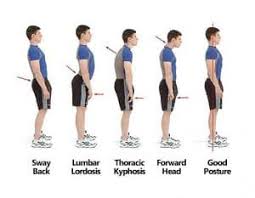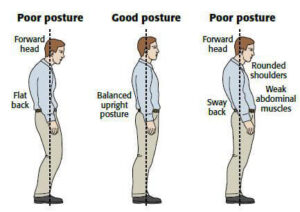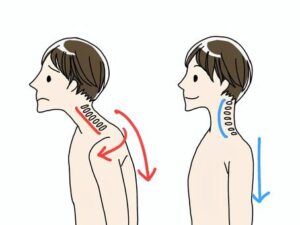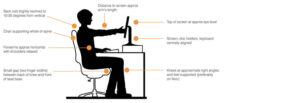

Neck pain is a widespread musculoskeletal issue affecting individuals across all age groups, often linked to prolonged poor posture.
As per a study published in the Journal of Orthopaedic & Sports Physical Therapy (2023), forward head posture (FHP) and other postural misalignments contribute to increased mechanical stress on the cervical spine muscles, leading to chronic pain and discomfort.
Understanding how posture correction techniques help reduce neck pain is crucial for managing and preventing this condition effectively.
Understanding the Relationship Between Posture and Neck Pain
Poor posture, particularly FHP, places excessive strain on the cervical spine.
According to research in the European Spine Journal (2022), every inch the head moves forward increases the effective load on the cervical spine by approximately 10 pounds, leading to muscular fatigue and joint stress.
This increased strain contributes to the development of musculoskeletal disorders, including tension headaches and reduced range of motion.
In addition, BMC Musculoskeletal Disorders (2023) reported that individuals with prolonged FHP are 40% more likely to experience chronic neck pain due to continuous strain on the supporting soft tissues.
This condition is particularly prevalent among office workers and individuals who spend extended periods using electronic devices.
Biomechanical Effects of Poor Posture on the Cervical Spine
Prolonged poor posture can cause significant biomechanical changes in the cervical spine, leading to long-term health complications.
As per Clinical Biomechanics (2022), habitual slouching and forward head posture (FHP) contribute to spinal misalignment, altering the natural cervical curve and increasing the risk of conditions such as cervical spondylosis and disc degeneration.
These structural changes often result in persistent discomfort, stiffness, and reduced mobility.
For example, office workers who spend long hours at a desk without ergonomic support often develop chronic neck pain due to poor posture habits.
Similarly, students who frequently hunch over their devices may experience early signs of postural strain.
A study published in the Journal of Bodywork and Movement Therapies (2021) found that sustained FHP leads to muscle imbalances, causing anterior neck muscles to shorten while posterior muscles weaken, further aggravating pain and discomfort.
Addressing these postural habits early can prevent long-term spinal degeneration and maintain overall neck health.
Neuromuscular Adaptations Due to Poor Posture
Poor posture doesn’t just mess with your muscles and bones—it also changes the way your body controls movement and balance.
When you sit hunched over for long periods, your brain starts to think that’s your “normal” position.
As per Frontiers in Neurology (2023), poor posture habits mess with proprioceptive feedback—the system that helps your body sense where it is in space.
This makes it harder to hold your head in the right position without constantly thinking about it, leading to ongoing neck pain and stiffness.
Think about how often we glance down at our phones or work on laptops in awkward positions. Over time, these habits trick our bodies into believing that misalignment is the default.
However, there is hope!
A systematic review in Musculoskeletal Science & Practice (2023) found that posture correction techniques focusing on proprioception can actually “retrain” the body, helping to restore better head and neck alignment.
With the right approach, good posture can become second nature again.
Impact of Posture on Muscle Activation and Fatigue
Sitting with poor posture does not just look bad—it actually makes your muscles work overtime.
Research in Applied Ergonomics (2022) found that slouching or craning your neck forward leads to excessive activation of key neck muscles like the trapezius and sternocleidomastoid.
This overuse causes fatigue and discomfort much earlier than it should. In fact, people with poor posture experience 30% more muscle activation compared to those who sit correctly.
That’s a lot of unnecessary strain! Addressing postural habits can go a long way in preventing neck pain and keeping those muscles from wearing out too soon.
Influence of Posture on Blood Flow and Oxygenation
Poor posture doesn’t just strain your muscles—it can also affect blood circulation and oxygen supply to the neck.
When your head is positioned incorrectly for long periods, it compresses blood vessels and restricts the flow of oxygen-rich blood to the muscles supporting the cervical spine.
According to The Journal of Physiological Sciences (2023), prolonged poor posture limits circulation, leading to the buildup of metabolic waste products, which causes stiffness, tension, and discomfort in the neck.
Over time, this reduced blood flow can contribute to muscle fatigue and chronic pain.
On the other hand, maintaining proper posture helps keep blood moving efficiently, ensuring that muscles receive the oxygen and nutrients they need to function optimally.
Studies indicate that posture correction techniques not only improve circulation but also aid in reducing muscle stiffness and alleviating discomfort.
Addressing postural habits can make a significant difference in overall neck health and daily comfort.
Health Consequences of Untreated Poor Posture
Persistent poor posture and associated neck pain can have far-reaching health consequences.
As per Pain Medicine Journal (2023), individuals with chronic neck pain due to FHP are at an increased risk of developing conditions such as:
- Cervical radiculopathy: Nerve compression resulting in pain, numbness, and weakness in the arms.
- Cervicogenic headaches: Neck-related headaches that often mimic migraines.
- Reduced respiratory function: Studies show that poor posture can limit chest expansion, impairing lung capacity.
Addressing posture-related issues early is crucial to preventing these long-term complications.
Posture Correction Techniques and Their Effects
Posture correction techniques are designed to bring the spine back into its natural alignment and relieve undue stress on the cervical spine.
These techniques address the underlying causes of poor posture by improving muscle balance, joint positioning, and movement patterns.
According to the Journal of Physical Therapy Science (2022), postural retraining exercises and ergonomic adjustments have shown significant success in reducing neck pain symptoms, particularly in individuals with forward head posture and sedentary lifestyles.
A meta-analysis published in BMJ Open (2023) revealed that individuals who consistently practiced posture correction techniques experienced a 35% reduction in neck pain levels over a six-month period.
This evidence supports the effectiveness of targeted interventions in managing postural discomfort and preventing its recurrence.
Regular application of posture correction methods not only alleviates pain but also enhances mobility, reduces muscle fatigue, and promotes long-term spinal health.
Addressing poor posture proactively can significantly improve overall quality of life. After all, slouched neck leads to brain fatigue.
Psychological Impact of Postural Issues on Neck Pain
Poor posture doesn’t just affect your body—it can take a toll on your mental health too.
When you experience chronic neck pain from poor posture, it can lead to heightened stress, frustration, and even anxiety.
According to a study in Health Psychology Review (2023), individuals suffering from posture-related neck pain report significantly higher levels of stress and anxiety compared to those with proper alignment.
The constant discomfort can affect focus, productivity, and overall well-being.
The good news is that posture correction techniques do more than just ease physical pain—they also promote mental relaxation.
Improving posture helps reduce muscle tension, which in turn lowers stress levels and enhances mood. Correcting poor posture can foster a greater sense of confidence and well-being, making it easier to stay engaged and productive throughout the day.
By addressing both the physical and emotional impacts of poor posture, individuals can experience a more balanced and healthier lifestyle.
Workplace Ergonomics and Posture Correction
In today’s workplace, prolonged sitting and poorly designed workstations are major contributors to posture-related neck pain.
Many individuals spend hours hunched over desks, leading to muscle strain, spinal misalignment, and chronic discomfort.
According to the Occupational Medicine Journal (2023), poor workstation ergonomics are a leading cause of musculoskeletal disorders, with neck pain being a primary complaint.
The study found that implementing ergonomic interventions—such as adjustable desks, properly positioned monitors at eye level, and supportive chairs can reduce musculoskeletal strain by 40%, emphasizing the importance of optimizing workplace setups to promote better posture.
Simple adjustments, such as maintaining a neutral head position and ensuring feet are flat on the floor, can significantly ease pressure on the cervical spine.
Employers and employees alike can benefit from ergonomic improvements that enhance comfort, productivity, and overall well-being.
Addressing ergonomic factors proactively can prevent the development of chronic posture-related conditions and support long-term spinal health.
The Role of Wearable Posture Correction Devices
Thanks to modern technology, fixing poor posture is no longer just about sitting up straight when you remember. Wearable posture correction devices are here to do the job for you!
According to the Digital Health Journal (2023), users who consistently wore these smart gadgets saw a 25% reduction in neck pain and a noticeable improvement in posture awareness over three months.
Whether it’s a discreet sensor clipped to your shirt or a high-tech smart vest, these devices provide real-time feedback—vibrating or buzzing when you start slouching.
They are like having a personal posture coach that never takes a break!
With wearable posture trackers, you can stay on top of your alignment, whether you are at work, home, or binge-watching your favorite show. It is an effortless way to build better habits and keep neck pain at bay.
FAQS on Posture correction Techniques for Reducing Neck Pain
Q-1. How do posture correction techniques actually lower neck pain?
A-1. Most neck pain comes from overloaded tissues—think tight upper traps and tired deep neck flexors—because your head drifts forward.
Techniques like chin tucks, scapular setting, and thoracic extension drills redistribute the load so joints and muscles share the work evenly again.
Example: after a week of screen time, Priya did 10 gentle chin tucks and a doorway pec stretch twice daily; by day four her “ropey” neck felt looser and turning her head was easier.
Q-2. Which muscles matter most for pain relief?
A-2. Two sets are key: stabilizers and movers. Stabilizers (deep neck flexors, lower traps, and serratus anterior) keep your head and shoulders stacked; movers (upper traps, levator scapulae, pecs) often get overactive.
Posture routines wake up the stabilizers and downshift the movers. Example: Aman swapped shrugs for wall slides and prone Y’s; within two weeks his shoulders stopped creeping toward his ears, and those dull end-of-day neck aches faded.
Q-3. Can tiny desk tweaks really make a difference?
A-3. Absolutely. Small changes compound. Set your screen at eye level, keep elbows by your sides, and slide the keyboard close so you’re not reaching.
Add a “90-90-90” check (hips, knees, ankles) and plant your feet. Example: Meera raised her monitor with two books and brought her chair closer; combined with hourly 30-second posture breaks, her afternoon neck pinch dropped from a 6/10 to a 2/10 in a week.
Q-4. What’s a simple daily routine to start with?
Q-4. Try this 5-minute “reset”: (1) 10 chin tucks (slow, no chin jutting), (2) 10 wall angels or wall slides, (3) 30-second doorway pec stretch each side, (4) 10 thoracic extensions over a rolled towel, (5) 5 diaphragmatic breaths with long exhales.
Example: Ravi ran this routine after lunch and before bed; by day seven, morning stiffness eased and he stopped rotating his whole torso to check blind spots.
Q-5. How long until I feel results—and how do I keep them?
A-5. Many feel relief in days, but lasting change takes 3–6 weeks of steady practice.
Pair exercises with “habit hooks”: do a chin tuck every time you unlock your phone, or run wall slides after coffee. If pain lingers, add a pro check-in for manual therapy or targeted progressions.
Example: Lila added weekly physio plus her routine; within a month her headaches were rare and her posture felt “automatic.”
Conclusion
Slouching is not just a bad look—it is a pain in the neck, literally! Science has long confirmed that poor posture, especially forward head posture, puts extra stress on the cervical spine, leading to chronic discomfort and muscle imbalances.
According to research, fixing your posture can work wonders by realigning the spine, improving muscle function, and enhancing neuromuscular control.
The good news?
As awareness of posture’s impact on health continues to rise, adding a few simple posture tweaks to your daily routine can make a huge difference.
Whether at work or home, better posture equals a happier, pain-free you!
References:



